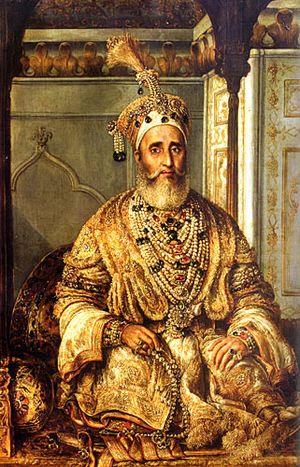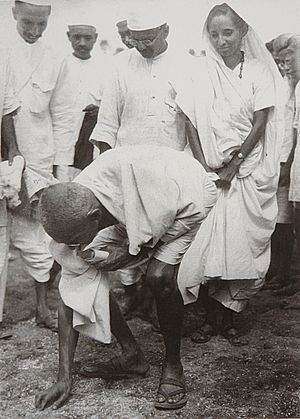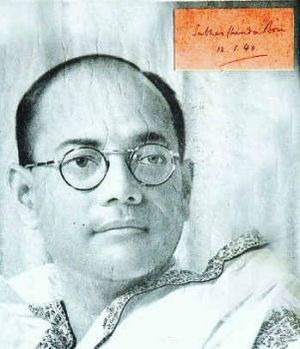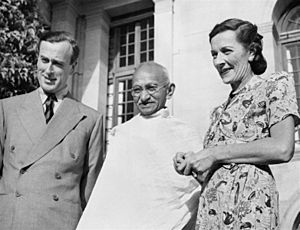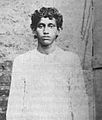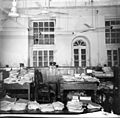Indian independence movement facts for kids
The Indian independence movement was a long struggle that helped India become a free country. It lasted from 1857 until August 15, 1947, when India finally gained its independence from the British Raj, which was the name for British rule in India.
Contents
- How European Rule Began
- The Great Revolt of 1857
- Organized Movements for Freedom
- World War I and Its Impact
- The Rowlatt Act
- Gandhi's Way to Freedom
- Civil Disobedience
- Revolutionary Activities
- The Elections of 1937
- India's Move Towards Freedom
- The Indian National Army
- The Quit India Movement
- India Becomes Independent (1947)
- Images for kids
- See also
How European Rule Began
Around 1498, Vasco da Gama from Portugal found a sea route to India. He landed in Kozhikode (Calicut, Kerala). After this, many Europeans came to India to trade. They built trading posts and forts. The British East India Company became very powerful. In 1757, the Company's army, led by Robert Clive, defeated the rulers of Bengal in a famous fight called the Battle of Plassey. This was the start of British rule in India, known as the British Raj. In 1764, the British won the Battle of Buxar. After this, they controlled important areas like Bengal, Bihar, and Orissa.
The British Parliament in the United Kingdom passed laws to help the British East India Company. Laws like the Regulating Act of 1773 and the India Act of 1784 were made to help their trade with India.
Even before the big revolt of 1857, many Indians fought against the British. Here are some examples:
- Local rulers in southern India, like Dheeran Chinnamalai and Veerapandiya Kattabomman, led revolts.
- In 1825, in Karnataka, Kittur Chennamma fought the British and won a battle. She refused to give them any money.
- In 1787, a revolt happened in Goa against Portuguese rule, known as the Conspiracy of the Pintos.
- Tribes in Jharkhand led a rebellion called the Santhal Rebellion.
- A rebellion also took place in Bengal led by Titumir.
The Great Revolt of 1857
The Revolt of 1857 is often called India's First War of Independence. It was a rebellion by Indian soldiers and ordinary people against British rule. It started in May 1857 and lasted until December 1858. Many things led to this rebellion.
The British rulers kept taking over Indian lands and adding them to the British Raj. They also showed little respect for old Indian royal families, like the Mughals. A big reason for the revolt was a new type of rifle cartridge given to Indian soldiers. Soldiers had to bite open these cartridges before loading them. Rumors spread that the cartridges were greased with cow and pig fat. For Hindus, cows are sacred, and they do not eat beef. For Muslims, pork is forbidden. This made soldiers of both religions very angry. Even though the British tried to change the cartridges, the anger remained.
The rebellion began when a soldier named Mangal Pandey attacked a British officer. He was later arrested and killed.
At first, the British were slow to react. But then they sent in strong forces, even bringing soldiers from the Crimean War. They surrounded Delhi from July to August 1857 and eventually took control after fierce street fights. Other important events included the massacre at Kanpur in July 1857 and the siege of Lucknow from June to November 1857. The last major battle was in Gwalior in June 1858, where the brave Rani of Jhansi was killed. By then, the British had mostly crushed the rebellion. However, some small-scale fighting continued until early 1859.
What Happened After the Revolt
The Revolt of 1857 was a huge event in India's history. In November 1858, the British Parliament took away the British East India Company's right to rule India. The United Kingdom then started ruling India directly through a representative called the Viceroy of India. India became a part of the British Empire. The British promised to treat Indian princes, chiefs, and people fairly under British law.
The British sent Bahadur Shah II, the last Mughal Emperor, out of India to Rangoon (now called Yangon) in Burma. He died there in 1862. This ended the Mughal dynasty, which had ruled India for about 400 years.
The British also started to employ more Indians from higher castes and royal families in the government, though mostly at lower levels. They stopped taking over the lands of Indian princes. They also stopped interfering in religious matters. They increased the number of British soldiers and only allowed British soldiers to handle powerful weapons like artillery.
Organized Movements for Freedom
After the 1857 revolt, the Indian independence movement grew stronger. Many new leaders appeared, and Indians became more aware of their rights. Social movements also helped change people's ideas, working to remove bad social practices like illiteracy and the caste system. Many social and religious leaders inspired Indian society during this time. These included people like Swami Vivekananda, Ramakrishna, Sri Aurobindo, Rabindranath Tagore, and Dadabhai Naoroji.
They spread messages of self-confidence, removing social problems, and freeing India from foreign rule. Lokmanya Tilak was one such leader who spoke boldly. The British arrested him, but in court, he famously declared: "Swaraj (independence) is my birthright!" This idea of Swaraj became a main goal of India's independence movement for many years.
In 1885, a retired British officer named Allan Octavian Hume suggested that Indians form a group. Seventy-three Indian delegates met in Bombay and started the Indian National Congress. These delegates were educated Indians like lawyers, teachers, and journalists. A few years earlier, Dadabhai Naoroji had formed the East India Association, which later joined the Indian National Congress.
At first, the Indian National Congress was not a very active political party. It met once a year and offered suggestions to the British rulers, mostly about civil rights and jobs for Indians in the government. While it claimed to represent all Indians, it mainly represented the educated and upper classes. Many Muslims did not fully trust it, especially because some Hindu reformers spoke against religious conversion and killing cows. Sir Syed Ahmad Khan started a separate movement for Muslims. In 1875, he founded a college in Aligarh, which later became Aligarh University in 1921. Its goal was to give modern education to Indian Muslims. By 1900, the Indian National Congress had become a national party, but it still didn't represent all groups, especially Muslims.
Partition of Bengal
In 1905, Lord Curzon, who was the Viceroy of India, divided the Bengal province into two parts: Eastern Bengal & Assam, and West Bengal. This made people very angry. They felt the British were trying to "divide and rule" them. Famous Indian poet Rabindranath Tagore even wrote a poem against this division.
World War I and Its Impact
During the First World War (1914-1918), Indians supported the United Kingdom. About 1.3 million Indian soldiers fought in Europe, Africa, and the Middle East. Many Indians, including princes and rich people, gave money and supplies for the war. However, many Indian soldiers died far from home. In India, a deadly flu called Spanish flu spread, killing many people. Taxes and prices also went up, making Indians restless.
In August 1917, the British government announced that they would give more rights to Indians. A new law, the Government of India Act of 1919, gave Indians more control over local matters like farming, health, and education in provincial governments. However, the British kept control over important areas like taxes and law and order.
The Rowlatt Act
In 1919, the British passed a new law called the Rowlatt Act. This law gave the government huge powers. They could arrest people and put them in prison without a trial. They could also stop newspapers from printing news. People called this law the Black Act. Indians protested against it everywhere.
The protests became very intense in Amritsar, Punjab. On April 13, 1919, about 10,000 Indians gathered at Jallianwala Bagh. They didn't know about the new law that banned large gatherings. The British military commander, Brigadier-General Reginald Dyer, ordered his troops to fire at the unarmed crowd without warning. The troops fired 1,650 times. Historians believe 379 people were killed and about 1,137 were injured. This terrible event became known as the Jallianwala Bagh massacre. After this, the British lost the trust of the Indian people.
Gandhi's Way to Freedom
Mohandas Karamchand Gandhi, also known as Mahatma Gandhi, was a lawyer who studied in London. In 1893, he went to South Africa. There, he was thrown off a train because he was a person of color sitting in a first-class seat. This unfair treatment made him decide to fight against injustice. He became successful in South Africa, and the government removed many unfair rules.
When Gandhi returned to India in 1915, he was not widely known. But over the next few years, under his leadership, Indians began to use a new way to fight for freedom: peaceful protest.
Civil Disobedience
In December 1929, the Indian National Congress Party decided to start a movement for complete independence from British rule. This movement was called the Civil Disobedience Movement. They chose January 26, 1930, as "Complete Independence Day." Many other political parties and revolutionaries supported this movement.
Gandhi started the movement by leading 72 people on a 400-kilometer walk from Ahmedabad to Dandi, a coastal town in Gujarat. There, they made salt from seawater. This broke a British law that said Indians couldn't make salt without paying taxes. This event is known as the Salt March. The Civil Disobedience Movement quickly spread across India. Indians began to peacefully break unfair laws to protest British rule.
Revolutionary Activities
Not all Indians believed in peaceful protests. Some thought that the British would not give independence easily and that armed struggle was needed to remove them from India. This idea had been around since the partition of Bengal in 1905. Many revolutionaries emerged, and Bhagat Singh was one of the most famous.
The Elections of 1937
The British rulers passed a new law to govern India called the Government of India Act 1935. This law aimed to set up a federal system with many provinces and give provinces more self-rule. It also tried to protect the Muslim minority by giving them separate elections where only Muslims could run for office. In February 1937, elections were held for provincial assemblies. The Indian National Congress Party won in five provinces and had a strong position in two more. The Muslim League did not do well in these elections.
India's Move Towards Freedom
During the Second World War (1939-1945), the British rulers declared India to be part of the war without asking Indian leaders. This divided Indians. Some supported the British, but many did not. Many Indians felt it was unfair that the British wanted them to fight for freedom abroad while denying India its own freedom. This led to great unhappiness and two major movements for independence: the Indian National Army led by Subhas Chandra Bose and the Quit India Movement led by Mohandas Gandhi.
The Indian National Army
Subhas Chandra Bose and many other leaders disagreed with the British decision to involve India in the Second World War. Subhas Chandra Bose had been president of the Indian National Congress Party twice. However, he had different ideas from other leaders and resigned. He formed a new party called the All India Forward Bloc. The British government put him under house arrest, but he escaped in 1941. He went to Germany and later to Japan, seeking their support to fight the British in India.
In 1943, he traveled by submarine to Japan and organized the Indian National Army (INA). The INA fought against the British in northeastern India. Despite many challenges, the INA won some battles. However, when Japan surrendered in 1945, the INA's operations stopped. Bose died in a plane crash, though the exact details are still unclear.
The British government put three INA officers on trial at the Red Fort in Delhi. They chose one Hindu, one Sikh, and one Muslim officer. This made many Indians of all religions very angry. A naval mutiny also broke out in Bombay. The British found the officers guilty but released them because of public anger. After India became independent, the government did not allow former INA soldiers to join the new Indian armed forces. However, they received good pensions and were highly respected by the Indian public.
Some people see Netaji Subhas Chandra Bose as a controversial figure because he worked with the Axis Powers during the war. But in India, he is widely seen as a patriotic hero of the independence movement.
The Quit India Movement
On August 8, 1942, leaders of the Indian National Congress Party met in Bombay (now Mumbai). They decided to launch a movement to force the British out of India. Gandhi's powerful slogan, "Do or Die," became a national rallying cry, and the movement was named the Quit India Movement. Earlier, at the start of the Second World War, the Congress Party had offered to support the British if India was granted freedom after the war. The British refused this offer. So, on July 14, 1942, the Congress Party passed a resolution demanding complete independence. However, some other political parties did not support this.
Gandhi asked people to keep the Quit India Movement peaceful. Many people started protests across India. But in some places, the protests became violent. Gandhi refused to eat until the violence stopped, and he succeeded in ending it.
The British reacted very quickly. They arrested over 100,000 people and fined many others. They even dropped bombs on protesters and beat people with sticks. All the Congress Party leaders were arrested. Gandhi's wife, Kasturba Gandhi, and his secretary, Mahadev Desai, died while in detention. Gandhi's health also became very poor. In 1944, the British released him, fearing that his death might cause even bigger protests. Gandhi continued to oppose the British and demanded that all other leaders be set free.
The Second World War greatly weakened the British Empire's power. They knew that after the war, Indians would launch an even bigger movement for independence. The mood of the British people and army had also changed; many no longer wanted to support British rule in India. By early 1946, the British leaders released all political prisoners in India and began talks about independence with the Indian National Congress Party. On August 14, 1947, Pakistan gained independence, and the very next day, August 15, India gained its independence.
India Becomes Independent (1947)
At midnight on August 15, 1947, Britain officially gave India its political independence. A short time later, Gandhi, who was old and unwell, was killed by a Hindu extremist named Nathuram Godse. The national leadership then passed to his main helper, Jawaharlal Nehru. On June 3, 1947, the Viceroy Lord Mountbatten announced the division of India into two countries: the Union of India and an Islamic Pakistan. This division led to many people dying and families being separated. On January 26, 1950, India adopted its own constitution, which is the longest constitution in the world.
Images for kids
-
The first session of the Indian National Congress in 1885.
-
Lala Lajpat Rai, Bal Gangadhar Tilak, and Bipin Chandra Pal, known as Lal Bal Pal.
-
Cover of a 1909 Tamil magazine Vijaya showing "Mother India" with "Vande Mataram".
-
The 1915 Singapore Mutiny memorial tablet in Singapore.
-
Gandhi and Abdul Ghaffar Khan at a rally in Peshawar, 1938.
-
Procession in Bangalore during the Quit India Movement.
-
HMIS Hindustan at Bombay Harbour, occupied by mutineers during the Royal Indian Navy mutiny.
-
Pandit Jawaharlal Nehru became the first Prime Minister of India in 1947.
-
Robert Clive with Mir Jafar after the Battle of Plassey.
-
The Last Effort and Fall of Tipu Sultan by Henry Singleton, c. 1800.
-
Statue of Bakshi Jagabandhu, leader of the Paika Rebellion.
-
Dadabhai Naoroji, a founding member of the Indian National Congress.
-
Lala Lajpat Rai of Punjab, Bal Gangadhar Tilak of Bombay, and Bipin Chandra Pal of Bengal, known as Lal Bal Pal.
-
Surendranath Banerjee, a founding member of the Indian National Congress.
-
Gopal Krishna Gokhale, a senior leader of the Indian National Congress.
-
Aurobindo Ghose, involved in nationalist politics and revolutionary movements.
-
Hare Krishna Konar, connected with Civil disobedience.
-
A wing of the Cellular Jail, Port Blair, where many revolutionaries were imprisoned.
-
Rajendra Prasad and Anugrah Narayan Sinha during Mahatma Gandhi's 1917 Champaran Satyagraha.
-
C. Rajagopalachari, an Indian nationalist.
-
Vallabhbhai Patel, President of Indian National Congress.
-
Chandra Shekhar Azad reorganized the Hindustan Republican Association.
-
Lal Bahadur Shastri, imprisoned for supporting the independence movement.
-
Lakshmi Sahgal, who set up the Rani of Jhansi regiment for women in the INA.
See also
 In Spanish: Movimiento de independencia de la India para niños
In Spanish: Movimiento de independencia de la India para niños


